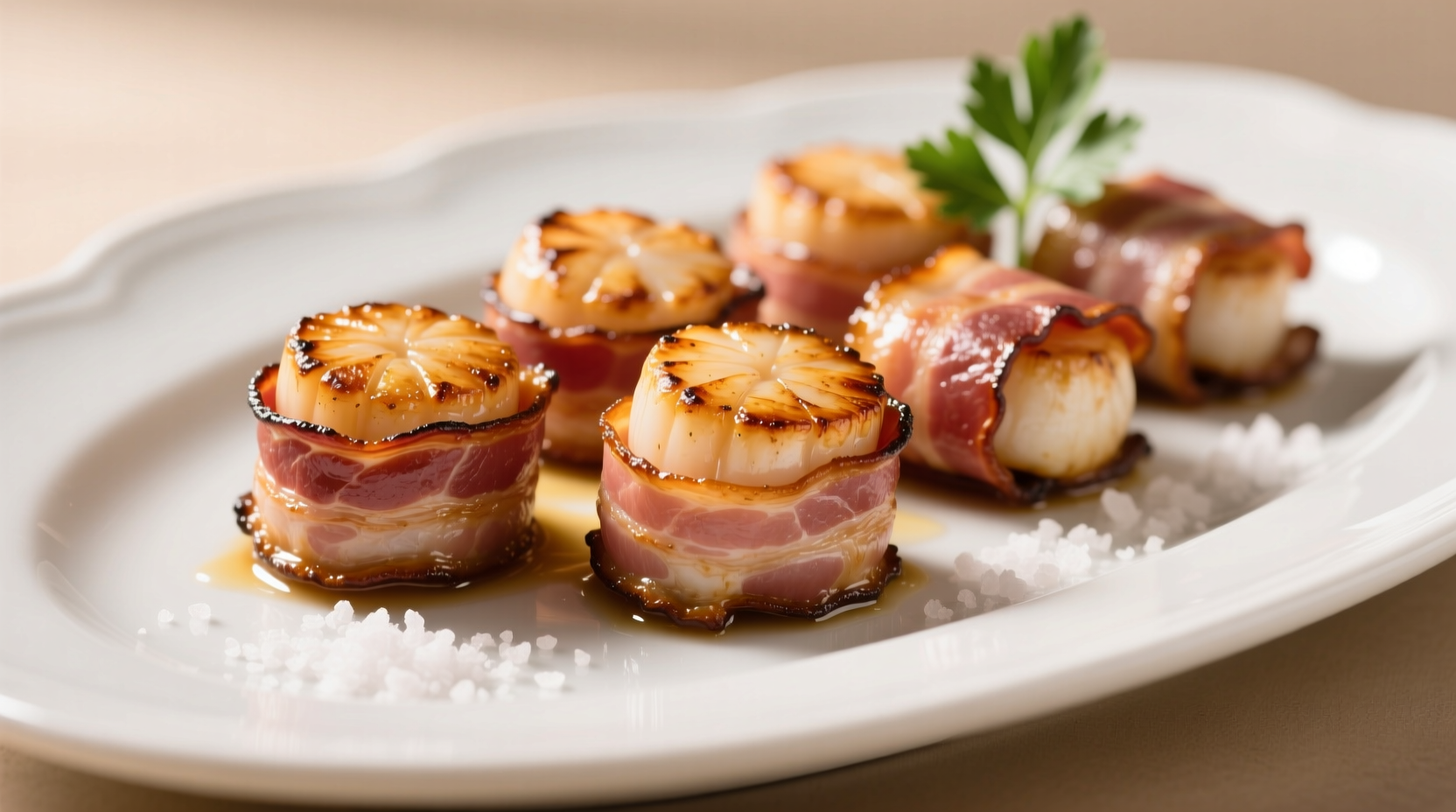Perfectly cooked bacon wrapped scallops require dry scallops, thin-cut bacon, and precise temperature control. Bake at 400°F for 12-15 minutes or grill for 8-10 minutes, flipping once, until bacon reaches 145°F and scallops hit 115-125°F internal temperature.
There's nothing quite as impressive yet simple as bacon wrapped scallops done right. As a chef who's prepared this dish for thousands of guests across fine dining establishments and casual settings, I've perfected a method that guarantees restaurant-quality results every time. Forget rubbery scallops or flimsy bacon - this guide delivers the crispy-yet-tender balance that makes this appetizer unforgettable.
Why This Method Works Every Time
The magic happens when you understand two critical factors: moisture control and temperature precision. Scallops contain 80% water - too much moisture prevents proper searing. Meanwhile, bacon needs consistent heat to render fat without burning. My technique addresses both through strategic preparation and cooking science.
Essential Ingredients Checklist
Quality ingredients make or break this dish. Here's what to look for:
- Dry-packed sea scallops (1.5-2 inches diameter) - Avoid "wet" treated scallops which won't sear properly
- Thin-cut applewood smoked bacon (1/16 inch thick) - Standard bacon works but requires longer cooking
- Optional: toothpicks (soaked in water for 30 minutes) or metal skewers
- Optional enhancements: black pepper, maple syrup, or fresh herbs
| Cooking Method | Time | Temperature | Best For |
|---|---|---|---|
| Oven | 12-15 minutes | 400°F | Most reliable home method |
| Grill | 8-10 minutes | Medium-high | Smoky flavor lovers |
| Air Fryer | 10-12 minutes | 375°F | Quick preparation |
| Saute Pan | 6-8 minutes | Medium | Small batches only |
Step-by-Step Preparation Process
1. Scallops: The Critical First Step
Proper scallop preparation makes the difference between success and failure. Follow this USDA-recommended seafood handling timeline:
- Thawing (if frozen): 24 hours in refrigerator (never at room temperature)
- Rinsing: Gently under cold water, then pat completely dry with paper towels
- Drying: Place on paper towels, cover with more towels, refrigerate 30-60 minutes
- Membrane removal: Pull off the small side muscle if present
This drying process follows FDA food safety guidelines for seafood preparation, reducing surface moisture that prevents proper browning. Never skip this step - it's why restaurant scallops sear perfectly.
2. Bacon Selection and Assembly
Wrap each scallop with 1/2 slice of bacon, overlapping slightly. Secure with a soaked toothpick or metal skewer. For best results:
- Stretch bacon gently while wrapping to ensure tight coverage
- Leave small gaps between bacon strips for even crisping
- Season lightly with black pepper (avoid salt - bacon provides enough)

3. Cooking Techniques Compared
While oven baking delivers the most consistent results for home cooks, each method has specific limitations:
- Oven method: Best for 6+ servings but requires preheating. Place on wire rack over baking sheet to allow fat drainage.
- Grill method: Creates smoky flavor but requires careful monitoring. Use indirect heat to prevent flare-ups.
- Air fryer method: Fastest option but limited capacity. Cook in single layer without overcrowding.
- Saute pan method: Works for small batches but difficult to cook evenly on all sides.
4. Temperature Control: The Secret to Perfection
Professional chefs use these precise temperature targets:
- Bacon should reach 145°F for safe consumption
- Scallops are perfect at 115-125°F internal temperature
- Remove from heat when bacon is 90% crisp - it will continue cooking
Overcooking is the #1 mistake home cooks make. Scallops become tough beyond 130°F. Use an instant-read thermometer for accuracy - it's worth the $15 investment.
Troubleshooting Common Problems
Bacon Isn't Crispy
This happens when bacon fat doesn't render properly. Fix it by:
- Starting with cold bacon (don't pre-cook)
- Using thin-cut bacon (regular bacon needs 3-5 extra minutes)
- Placing on wire rack for air circulation
Scallops Are Rubbery
Caused by either wet scallops or overcooking. Prevent it by:
- Drying scallops thoroughly (critical step!)
- Using proper internal temperature (115-125°F)
- Avoiding overcrowding on the baking sheet
Serving Suggestions That Impress
Serve immediately after cooking for best results. Pair with:
- Lemon-dill aioli for dipping
- Simple arugula salad with lemon vinaigrette
- Crisp white wine like Sauvignon Blanc
For special occasions, add a drizzle of balsamic reduction or maple syrup glaze during the last 2 minutes of cooking. The sweet-salty combination elevates this simple dish to restaurant status.
Storage and Reheating Guidelines
While best served fresh, leftovers can be stored properly:
- Refrigerate within 2 hours of cooking in airtight container
- Consume within 2 days (per FDA seafood safety guidelines)
- Reheat in 350°F oven for 5-7 minutes (never microwave)
- Do not refreeze after cooking











 浙公网安备
33010002000092号
浙公网安备
33010002000092号 浙B2-20120091-4
浙B2-20120091-4